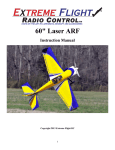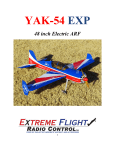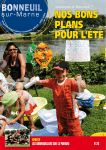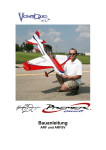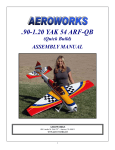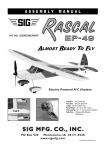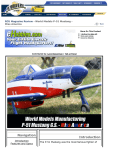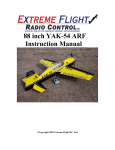Download QuiQue's Aircraft 102" YAK 54 Specifications
Transcript
Semi Scale Yak-54, ARF 102” Generation II ASSEMBLY MANUAL Specifications Wingspan: Length Including Spinner: Wing Area: Weight (RTF): Recommended Engines: Gas 102 in 91 in 1,975 sq in 25-28 lb 100-110cc Table of Contents Quique’s Aircraft Company Covering Colors Going Over the Covering Hardware Supplied Additional Required Tools and Adhesives Servo Selection Using the Manual Warning Warranty Information Section 1-Preparing Fuselage Section 2-Horizontal Stab Installation Section 3-Elevator, Rudder and Aileron Control Horn Installation Section 4-Preparation and Installation of Hinges Section 5-Wing Anti-Rotation Pins and Servo Installation Section 6-Tail Wheel Installation Section 7-Elevator Servo Installation Section 8-Rudder Servo and Pull/Pull Installation Section 9-Engine Mounting Section 10-Landing Gear Installation Section 11-Fuel Tank Installation Section 12-Engine Cowling Section 13-Canopy Installation Section 14-Radio Equipment Balancing the Model Control Throws Preflight at the Field DA100 and 3W 106 Engine Template 3W-106 Canister Support Dimension 3 4 4 5 6 8 8 8 8 9 10 12 14 17 21 22 24 26 33 35 37 39 40 44 45 48 49 50 2 Quique’s Aircraft Company 3410 Saint Paris Pike Springfield, OH 45504 Phone: (937) 629-0339 Fax: (937) 629-0335 Email: [email protected] Website:www.QQAircraft.com Online-Support:http://www.rcuniverse.com/forum/forumid_437/tt.htm Quique and I want to express our thanks to you for choosing our 102” Yak-54. We think that you will enjoy one of the best flying model aerobatic airplanes available. It is patterned after the 37% Yak-54 which took First Place honors at 2006 Don Lowe Masters Champion and 2006 Tucson Free Style Champion. The 2003 Free Style Championships in Lakeland Florida, First Place at the Don Lowe Master competition 2003 & 2004, First Place Tucson Shoot Out 2004 Free Style, First Place XFC 2004, precision and free-style and Third Place at the Tournament of Championships in Las Vegas in 2002. We have tried to prepare the best assembly manual possible along with best support on our line of Aircraft. We are happy to announce that we have a support forum on www.Rcuniverse.com that is being led by Mr. Reza Gholamipour. Imagine, you are building your plane during the weekend when we are closed and you desperately need to get an answer to your question to continue building. Well we are happy to tell you that your question has most likely already been asked and answered on the RC Universe forum “Quique’s Aircraft Support.” If not, just post your question on the most appropriate thread and have the answer in matter of hours. Also we would like to ask you to check our support forum for any updates that may pertain to your aircraft before starting your assembly process. Good flying to you! Quique, Sandra, Wayne, Molly and Reza 3 Covering Colors Ultra-cote covering used on this 102” Yak-54 can be purchased from Horizon Hobbies Website. The codes are as follows: Deep Blue True Red White Bright Yellow Hanu873 Hanu866 Hanu870 Hanu872 Going Over the Covering Before beginning the assembly of your Yak-54, remove each part from its bag for inspection. If you find any wrinkles in the covering, use a heat gun or covering iron to remove them. Use caution while working around areas where the colors overlap to prevent separating the colors. Make sure you go over the edges with your iron as well. 4 Hardware Supplied Pull/Pull Rudder 30 Hinges and Wing pins/clips Tail Wheel Aileron/Elevator Titanium rods & ball links Fuel Tank Canopy hardware Cowl hardware Optional Dubro Hardware to complete your Assembly: Wheels and Axles Control Horn System 5 Additional Required Tools and Adhesives • Covering/Trim iron • Xacto knife, #11 blade • Pacer hinge glue (PT-55) • 5, 15 and 30-minute epoxy • Petroleum jelly/Lithium grease • Acetone/Alcohol swabs • Felt-tip marker • Pencil and Marker • Ruler • Drill • Drill bit 1/16”,1/8”, ¼”, 3/16”, #33, #25, #54 • Wire cutter • Course and fine sandpaper • Thin, medium and thick C/A • Full threaded servo mounting screws • Sullivan inner nyrod • Pliers • Masking tape • Ultra fine point sharpie • Electrical tape • Double-sided tape • Rat-tail file • Pin vise • Round toothpick • Velcro • Thread Locker Extensions: • (2) 24” and (2) 3” servo extensions for Ailerons • (2) 48” servo extension for Elevators • (1) 24” servo extension for throttle • (2) 12” servo extension from Aileron matchbox to Receiver 6 All Other Parts Required to Complete the Aircraft • • • • • • • • • • • • • DA100 or similar engine MTW 75 Canisters with 50mm drop down header or Stock Mufflers or similar set up for different engine 1.5” Aluminum stand offs (8) JR 8611a or similar Digital servo (1) JR 4735 or similar analog servo (4) 1.5” and (2) 1.25” single side Aluminum servo arms and (2) 3” double side aluminum servo arm for all control surfaces. (1) Plastic servo arm for throttle. (1) 4000 mah Li-Ion Duralite plus battery or similar for Receiver (1) 2000 mah Li-Ion Duralite plus battery or similar for ignition (1) Heavy-duty regulated failsafe switch such as Duralite #65060-HD for receiver (1) Duralite digital switch with built-in 5.5v regulator for ignition (P/N #80401) or similar (1) 8-channel receiver (1) 4 ½” Airwild Extra style spinner or similar (1) NX or Mejzlik 27x10 2-Bladed Prop 7 Servo Selection The servos used for the control surfaces of this Yak-54 are as follows: Ailerons (4), JR 8611a Elevator (2), JR 8611a Rudder (2), JR 8611a Throttle, any standard analog servo Make sure you use same or equivalent torque servos that are digital. Please do not risk your plane by using low torque or analog servos. This Yak-54 has large control surfaces and fully capable of any maneuvers that a pilot is able to perform. Therefore, using weak servos will increase chance of flutter and may result in a crash. Using the Manual This manual is divided into sections to help make assembly easier to understand and to provide breaks between each major section. Remember to take your time and follow the directions. Warning I am sure that for the most of you this is not your first venture into the World of flying radio-controlled aircraft. For those of you that may be entering this exciting sport early on in your modeling experience and for you with vast experience, I think we all need to be reminded of the possible dangers that are associated with a high performance aircraft of this type. This is not a toy. This aircraft must be flown in a safe manner at all times. You should always do a preflight check including control surfaces hook-ups, radio operation, (please refer to your radio equipment instruction manual for range checks and other pertinent related information) and all other checks relating to the safe operation of this aircraft. Warranty Information Quique’s Aircraft Company guarantees this kit to be free from defects in both material and workmanship at the date of purchase. This warranty does not cover any parts damaged by use or modification. In no case shall QQAC’s liability exceed the original cost of the purchased kit. Customer is responsible to check all the components upon receiving of his aircraft and notify QQAC in case of any visible damage to any parts. Customer should not proceed with building the aircraft as some damages can compromise the integrity of the structure of the aircraft, resulting in more damages. In no case will such damages be covered by QQAC. 8 Section 1-Preparing Fuselage Required Tools and Adhesive • • Xacto knife, #11 Blade Trim Iron Step 1 Use an Xacto knife with a # 11 blade and cut away the film covering on both sides of the fuselage for the wing openings, Figure 1. Some modelers may want to overlap the film covering down inside the fuse in the opening for the wing. For example this type of an opening for the wing may be done as follows. Simply cut the film about 1/8 of an inch to the inside of the opening for the wing. You may then bend this extra 1/8 inch flap of film over ninety degrees to the inside of the fuse opening and iron it to the edge of the balsa sheeting over the foam. Use the trim iron for this application. Do not touch the foam (bead board) with your trim iron. Watch how much heat you use here as too much will melt the foam. Figure 1 9 Section 2-Horizontal Stab Installation Required Tools and Adhesive • • • • • • • Rat-tail File Acetone Xacto knife, #11 Blade Course sandpaper Thin CA 5-minute epoxy Microballons Step 3 Prepare the C/F anti-rotation pins by using coarse sandpaper and rough up the end of the pin where it will be inserted in the second rib in the H.Stab. Now clean the pins with acetone or alcohol to remove any possible grease or dirt. Step 1 Step 4 Use an Xacto number 11 blade and cut open the film covering over the area at the rear and on both sides of the fuselage for the horz. stab. tube and for the anti-rotation pin openings. Also open the covering where the two screws will be used to attach both the left and right horz. stabs in place. Use 5-10 minute epoxy to attach the pin to the number two rib that is inside the horz stab. Then use thin C/A to attach the pin to the root rib of the horz stab. Step 5 Add a little extra fillet of epoxy with micro-balloons on the inside rib around the anti-rotation pin to insure a strong bond for the pins. Figure 2 Step 2 Step 6 Open the long slots where the rudder cables will pass through the rear of the fuse. If the anti-rotation pins fit too tightly in the fuse sides, it will be necessary to open the 10 holes in the fuse sides slightly with a small rat tail file. Very Important: After completing the model and flying it, in case you noticed any play in the stab, please glue the horizontal stab tube in place in the fuselage with epoxy and micro-balloons. 11 Section 3-Elevator, Rudder and Aileron Control Horn Installation Required Tools and Adhesive • • • Xacto knife, #11 Blade 5-10 minute epoxy Alcohol Swab/Alcohol and paper towel The Optional Du-bro package that we offer will have everything you need to complete the following steps, otherwise please use your alternative. Elevator Horn Installation covering film on the top of the elevator. Be sure that you do not put too much epoxy in the hole and on the screw. If necessary, you may want to put a small pin hole in the top covering just above the hole to allow the excess epoxy to escape. Clean excess epoxy with an alcohol swab. Step 1 Locate the elevator control horn hole that is covered by ultracote. Remove the covering from bottom by xacto knife. Step 2 Attach the Du-Bro Heavy Duty Control Horn System, Cat. No. 866. The hole is pre-drilled in each elevator to accept the 8-32 X 2” socket head cap screw. Use a Dremel cut off wheel and remove the socket head of the 832 socket head screw just below the screw head so you preserve as much length of the screw as possible. Step3 Clean the screw with alcohol,l and epoxy in place through the bottom of the elevator in the hard point provided. Insert full depth in the hole with the head end of the cut off 8-32 screw entering all the way to the Figure 3 Step 4 After insertion the 8-32 screw should protrude to a length of 1 inch measured from the bottom of the elevator. Rudder Control Horn Installation Step 1 Locate the pre-drilled rudder control horn hole that is covered by ultracote and remove the covering by xacto knife or a solder. Step 2 12 Use the Dubro heavy duty dual pullpull system Cat. No. 882. Insert the 8-32 threaded rod for the rudder control horn. 8-32X3 round Slotted/Phillips Zinc Machine screw at Lowes or similar supplier. We include those screws in our optional Du-Bro package. Step 3 Step 3 Take the screw out and apply a thin layer of epoxy/alcohol inside the hole to strengthen the inside walls. Step 4 Proceed with final installation of Dubro Cat. No 882. See Figure 4. Use epoxy and screw the machine screw into the hole provided until it reaches the top of the aileron. Cut off the head of the screw leaving a length of the control horn measured to the bottom of the aileron as follows: For the inboard horn, 1 inch, for the outboard horn 1-1/4 inches. After you have installed the servos, you are ready to hook up the linkage. Figure 4 Aileron Horn Installation Step 1 Locate the aileron control horn hole and servo locations that are covered by ultracote. Remove the covering from bottom by xacto knife. Step 2 Use the Du-bro Heavy Duty Control Horn System, Cat. No. 866. However the 2” 8-32 socket head cap screw provided is not long enough for the aileron control horn. Purchase 13 Section 4-Preparation and Installation of Hinges Required Tools and Adhesive • • • • Xacto knife, #11 Blade Lithium grease/Petroleum Jelly Toothpicks Pacer hinge glue (PT-55) The hinge slots are already cut in the balsa at all hinge locations on both the fixed surfaces and the moveable surfaces. However, they are covered up with the covering film so they may be a little difficult to see and locate. Look closely and you will find the hinge slots. Run your finger along the edge where the hinges are located. You should feel a little depression in the film at each hinge slot under the film. Number of slots and hinges per control surface are as follows: Aileron 9 Elevator 4 Rudder 4 14 Step 1 Step 3 Use a # 11 blade to open the flat hinge slot. The hinge slots will have to have a larger opening cut out just on either side, top and bottom, of the pivot point on both surfaces. So you will need to open the area in the fixed and moveable surfaces of the ailerons, elevators and rudder. Step 2 Use a #11 blade and make a wedge tapered opening to accept the pinned hinge area of the hinge. See Figure 5 & 6. Make a V- cut in the fixed and control surface area along the slot location of the flat hinge. This additional V- slot will insure that the hinge will insert far enough into the hinge slot so it is in the proper location and provide enough depth for each hinge. The gap between the flying surface and the control surface needs to be at a minimum. However we have to have enough of a gap so full deflection is possible. Check deflections before bonding hinges. Step 4 Check the gap on each control surface. The gap should be at minimum and yet make sure you get the maximum throw. This procedure will take some time to do all of the hinges but take your time and do a nice job. As you do each hinge and check out the proper depth and shape of the V-slot necessary for each hinge, the time involved to do each subsequent hinge will lessen. Figure 5 Before you glue the hinges in place: Dry fit the control surfaces to fixed surfaces. Make sure everything is lined up and full deflections are possible. Take some lithium grease or Petroleum jelly and apply a very small amount on both sides of the hinge point on the flat hinges. Quique used a round toothpick. See Figure 7 This will help prevent any glue in the pivot point. Figure 6 15 Be very careful not to get any grease etc. on the flat part of the hinges. Also remember that you always glue the hinges in to the fixed surfaces first, let the glue harden before you then glue in the control surfaces. Remember to check for the correct hinge gaps for rudder, elevators and ailerons. You must have the correct gap to insure the maximum control deflection necessary for the best 3-D aerobatics. For hinge attachment we like to use Hinge Glue by Pacer. You may use epoxy if you wish. If you use epoxy, use an epoxy with a curing time that will give you enough time to work the hinges in place before the epoxy hardens. For each aileron, cut 44 1/4”x1” of bright yellow ultracote and seal the hinge line from top using a straight edge and trim iron. For each half elevator, cut 14 1/4”x3/4” of bright yellow ultracote and seal the hinge line from top same way as you did your ailerons. Following figures show what it would look like if you use bright yellow ultracote to seal the hinge line from top. Figure 8 Figure 7 Step 5 Sealing the Control Surfaces After you are done hinging the ailerons and elevators, make sure you seal the hinge line by using clear ultracote or bright yellow ultracote for best appearance. Unsealed control surfaces may cause flutter like aileron flutter, which may cause your plane to crash, where sealed control surfaces will give you better and crisper response in flight. Figure 9 16 Section 5-Wing Anti-Rotation Pins and Servo Installation Required Tools and Adhesive • • • • • • • • • 5-15 minute epoxy Ruler Coarse sandpaper Acetone/Alcohol swab Thin C/A Micro balloons (2) 24” servo extensions (2) 1.5” aluminum servo arms Long rod such as 48” Dubro rod. Figure 10 Step 1 Prepare the aluminum anti-rotation pins by using coarse sandpaper and rough up the end of the pin where it will be inserted in the second rib in the wing. Now clean the pins with acetone or alcohol to remove any possible grease or dirt. Step 2 Install the anti-rotation pins using the following dimensions. The front pin should measure 10.5mm. Note: the picture showing the measurement with the ruler may not look like exactly 10.5 however 10.5 mm is the correct distance from the root rib to the center hole for the keeper clip at the end of the anti-rotation pin. Also this ruler starts at zero, yours may not start at zero. The rear pin should measure 8 mm from the root rib to the center of the hole. The front and rear pin should have the hole in a vertical position. Figure 11 Step 3 Apply 5-minute epoxy in the second wing rib holes. Lay the wing flat on the table to insert the anti-rotation pins. Now insert the pins to the correct depth. Again, check the hole 17 in the end of the pins to make sure the front and rear pins are vertical as this is very important Step 6 Step 4. Let the epoxy harden. Stand the wing on its wing tip and run some thin C/A around the root rib. Wipe away any excess. Do this several times which will help to seal the pin to the hole in the root rib. Step 5 You will find some ¼” I.D. O-rings and washers with the wing antirotation package of parts. Use thin C/A and glue the O-ring to the washer. After you have installed the wings to the fuse you will use this Oring and washer to slide over the anti-rotation pin before you put the keeper clip in the hole in the antirotation pin. After the C/A has hardened, make a fillet of 15 minute epoxy and micro balloons and apply on the inside of the root rib. I used a small length of 3/16” wooden dowel to apply the epoxy-micro balloon mix. Figure 14 Step 7 Figure 12 Now install the aileron servos the way that output shaft is towards the leading edge of the wing. Figure 13 18 Step 8 Plug a 24" servo extension onto the outboard servo. Either tie the servo leads together, using a commercially available connector, or use unwaxed dental floss to secure the extensions to prevent them from coming loose during flight. Step 9 To run the servo extensions, use a long rod and make a little hook at one end of it. Pass it through the wing panel and connect your servo lead to the hook with masking tape and pull it through. Figure 17 Step10 Use 3” extension for inboard servo and install the servo. Step 11 Use 1.5” aluminum servo arms. Step 12 Figure 15 Measuring from hinge line vertically to pivot point on the Dubro Control Horn connector should be at 1.7” inches for the proper amount of aileron throw. Hook the servo arm to the control horn using the provided 4/40 titanium rods. Use provided ball links to complete the installation. Note that you don’t need more throw than 45 degrees for Ailerons. Don’t alter the set up to get more than 45 degree deflection. Figure 16 19 Figure 18 Step 13 You need to use matchboxes for best results. Make sure that servos are not fighting each other throughout the travel. Follow matchbox instructions for proper set up. 20 Section 6-Tail Wheel Installation Required Tools and Adhesive • • • • Drill Thread lock Course sandpaper 5-minute epoxy Step 1 Insert the three screws to attach the tail wheel bracket. Figure 19 Step 2 Attach the small piano wire control steering arm and be sure to use thread lock on all the screws. Make a little double bend in the wire control steering arm so it will fit in the rudder steering point in the rudder. Use the small ball link provided to insert into the bottom of the rudder to accept the steering arm wire. Step 3 To attach the ball joint in the bottom of the rudder, drill a hole with the correct diameter and epoxy the ball joint in place. For better adhesion, rough up the shaft end of the ball joint that is to be inserted into the bottom of the rudder with course sandpaper. 21 Section 7-Elevator Servo Installation Required Tools and Adhesive • • • • (2) 48” servo extension Pin vise 1/16”drill bit 1 1/4” aluminum servo arms Step 1 Install the servo in its place. Figure 20 Step 2 Pull the servo wire through the rib access holes closest to the tube sleeve. Step 3 Install a 1-1/4” aluminum servo arm on servo output shaft. Step 4 Figure 21 Use a 2 inch Hanger 9 titanium control rod and on the servo end of the control rod, use a 4/40 Ball Link. The plastic Du-bro control linkage does not have any threads taped for the 4/40 control rod so you may put the left hand threaded end of the control rod there. Then the 4/40 ball link that you use can be the standard right hand threaded version. Step 5 Run 48 servo extensions from servos to receiver. Step 6 To run the servo extensions, use a 48” rod and make a little hook at one end of it. Step 7 Pass it through the fuselage and connect your servo lead to the hook with masking tape. Pull it through the fuse. 22 Figure 22 Figure 23 Figure 24 23 Section 8-Rudder Servo and Pull/Pull Installation Required Tools and Adhesive • • • • • Z-42 thread locker (Pacer) Thin C/A 0.05 Allen wrench (4) full-threaded servo screws Wire Cutter You will need a total of 500 inch ounces of torque on the rudder. The rudder servo tray has three servo openings. Example, if you are using JR 8411 servos, you should use three servos. If you are using the JR 8611 servos, you will only need to use two. We are using two JR 8611servos in this manual. For the pull/pull control system for the rudder, you will need to cross the cables. Be sure to put a length of Sullivan Gold-N-Rod # 504 over one of the cables to prevent possible RF signal generation that is just waiting to crash your plane. Step 1 Install the rudder servos with the output shaft toward the front of the fuselage. Step 2 Check provided pull/pull cable to make sure its covered with plastic, if not take a piece of inner Ny-Rod and slip a long piece over one of the cables. This will prevent radio interference. Step 3 Insert the cable connector sleeve over the cable through the small end of the connector. Tie a knot and pull the cable back thru the threaded end of the connector and insert the 4-40 threaded rod and tighten with a 0.050 Allen wrench. Important: Be sure to use Pacer Z-42 Thread Locker or similar on the 4-40 threaded rod that goes into the cable connector sleeve. Figure 25 Make careful measurements on the final length needed before you attach the cable connectors on the final end of the cable. You do have some length adjustment available but most of that adjustment should be for the final cable tensioning process. 24 Figure 26 Figure 27 Step 4 Step 8 Attach the double CF arm to your servo arm and mark the holes you want to use to couple the servo to your second servo. After you fly the airplane for 3 to 5 flights you will need to readjust the cables because they will get to “their place”. After that you should check the cables every 50 flights or so. Step 5 Drill the holes and adjust your pullpull system with the first servo that has the double CF arm. Step 6 Attach the second servo to the first servo by using provided ball links and 1.5” titanium rods. Step 7 Connect your matchbox and adjust the travel of both servos according to your matchbox instructions. Make sure that servos are not fighting each other through out their travel. 25 Section 9-Engine Mounting and Throttle Control Installation Required Tools and Adhesive • • • • Drill 1/8”, ¼” drill bits Sullivan Locking Sleeve Ball Joints S560 2-56 Rod DA100 and 3W 106 engine mounting templates are the same. Stand off size: DA100 with stock mufflers: 1.5” DA100 with Canisters: 1.5” 3W 106: ¾” Step 2 Mark the four engine mounting bolt holes through the template and onto the firewall and drill the holes. Step 3 Insert ¼” blind nuts from inside the firewall. Note that the bottom two blind nuts need to be trimmed in order to fit in the box. Engine template provided at the end of this manual is the same for above engines and exhaust combinations. DA100 Engine Installation Step 1 Figure 29 Snap the DA 100 template into the front of the engine box and line it up with the top of the box and in between the tri-stocks. If you have a Gen-I Yak please go by the measurements provided. Figure 30 Step 4 Figure 28 After blind nuts are completely pulled in, add some glue to the sides of them. 26 Step 5 Use 1.5” stand offs for both canister or stock muffler installation. Step 6 You can make those stand offs from 1” hardwood dowel that can be bought from a local store like Homedepot. Cut them to the desired length depending on your installation. Soak them with CA and let them dry. Let me emphasize that all of the stand offs need to be exactly the same size, otherwise your engine crankcase will take lots of unwanted load. Figure 32 Figure 33 Figure 31 An alternative would be aluminum stand offs which we recommend over the wooden stand offs. Figure 34 27 Step 1 Remove the covering from the bottom of the fuselage and leave 1/4” ultra-coat, so you can iron the covering down nicely into the opening. Figure 35 Figure 38 Step 2 Figure 36 To avoid cutting the header, remove the covering in front of the landing gear and then remove the stringers. This will not weaken the structure of your plane. Note that you can avoid this step by cutting 1” or slightly more off of the headers. According to Desert Aircraft the shortest that header can be is 9.5” long. Figure 37 DA100 Engine Installation with MTW Canisters Header drop down should be 50mm and canisters are MTW 75, front exit that can be purchased from Desert Aircraft. 28 Keep in mind that if you are using flex headers with the Teflon tape, it is ok to remove the tape if you need more range of motion from the flex portion of the headers. The Teflon tape is supplied on the headers to help alleviate leakage out of the flex portion of the header. Figure 39 Step 3 Modify the canister support to fit it in the tunnel. DA provides a support and silicone tubing with the MTW header/canister system but it is too tall and not wide enough but it can be modified to fit as shown in figure 40. Figure 41 Figure 42 Figure 40 Step 4 Insert the support into the tunnel. Do not glue yet. You need to dry fit everything to make sure there is no problem. Depending on the mount you received, you may need to add scrap wood to the sides to give it a tight fit. There will be about 4 mm space between the aluminum landing gear plate L-Bracket and cans. To be on the safe side and make sure they won’t hit in vibration causing interference, grind away the sharp corners of L-bracket with a Dremel. Make sure to cover the exhaust ports on your DA-100 while grinding to keep any metal flakes or dust out of the cylinders. 29 Figure 43 Figure 44 Once you are satisfied with the fit of the canister support and the clearance of the canisters, glue the mount in place near or against the former that is approximately 5” behind the landing gear using epoxy between the sides of the support and the fuselage. You may also add triangle stock to the joint for more bracing. Once the epoxy has set, run a bead of thick CA along the bottom of the mount to secure it to the balsa floor. Slide each canister into the canister tunnel and secure the headers to the engine. Use the supplied gasket or Red, high temperature RTV silicone gasket maker to alleviate any leaks around the engine exhaust area. Secure with provided socket screws. Step 5 Attach the headers and canisters to the Teflon couplers. DA recommends that you use the spring clamps as opposed to any type of hose clamp as Teflon will tighten up with the heat and the spring clamps will adjust to the change. A good tool to use is a pair of vice grip locking pliers to spread the clamp over the coupler. 3W 106 Engine Installation with Canisters Step 1 Remove the covering from the bottom of the fuselage and leave 1/4” ultra-coat, so you can iron the covering down nicely into the opening.. Step 2 Make a canister support out of 1/16” plywood to the dimension provided at the end of this manual. Step 3 Canisters used for this set up is 3WM that has 50mm diameter. The correct headers should be ordered from Aircraft International. The 1/16 inch plywood canister mount fits in front of the former that 30 is approximately 5 inches behind the back of the landing gear. Glue in the ply canister mount with epoxy on both sides to the sides of the fuse former. After the epoxy hardens, add some thick C/A along the bottom of the canister mounting plate, as viewed from the opening in the bottom of the fuse and also along the opposite side. Figure 45 Figure 47 Figure 48 To avoid any contacts of silicone tubing and cans,tie your tubing as in Figure 49 below. Figure 46 Figure 49 DA-100 and 3W 106 Throttle Control Hook-up Throttle tray is ready for you to install your servo. Please see pics below. 31 Figure 50 Figure 51 32 Section 10-Landing Gear Installation Required Tools and Adhesive • • • • • • • Drill, 3/16”(4.5mm) and 5/16” drill bit Axles Dubro Cat No.249 4” Threaded light wheel Cat No. 400TL Dremel Dremel grinder and cutting wheel Felt tip pen (2) 4-40 socket cap screw Landing gear comes drilled and ready to install but you still need to drill the holes for axles and wheel pants. If you have any problem inserting the bolts through the landing gear to the plate, please redrill through the existing holes to make sure that there is no debris in the holes. Step 2 Landing gear is made of GlassEpoxy. Before drilling, make sure to use a piece of wood and clamp it to the gear. This will prevent the back side from popping out. If you don’t have the exact drill bit size(5/16”) that fits the axle, use ¼” drill bit for the first hole and then use the axle itself to drill the exact size hole for your axle. When using the axle you need to be careful not split the gear. Do it slowly and if any problem back out the drill and try again. Step 1 Wrap 2 rounds of masking tape to the leg of the landing gear that you are going to drill. Mark the center of the hole. Figure 53 Figure 52 Figure 54 33 Step 3 Using a 3/16” drill bit, drill a hole into the wheel pants. Step 4 With dremel and grinding tool, make a larger pocket around the axle hole to fit the axle hex-nut onto the wheel pants. Figure 57 Step 5 Mount the gear so it is swept forward and adjust the wheel pants to the correct angle. Drill the setscrew hole through the gear and wheel pants using a 3/32” drill bit. Step 6 Figure 55 Insert the provided blind nuts (or use 4-40 blind nuts, not provided) for the set screw into the wheel pants and install on landing gear. Figure 56 Figure 58 34 Section 11-Fuel Tank Installation Rear Plate: 178mmx45mm. Required Tools and Adhesive • • • • • 15-30 minute epoxy Velcro or tie wraps 18” long ¼” thick lite-ply or plywood Sandpaper Sticky back Velcro Step 1 Assemble the fuel tank hardware as shown. See Figure below. Be sure the vent tube with the short piece of fuel tubing is cut at an angle that is located at the top of the inside of the fuel tank when the tank is mounted in vertical position. The tank should be mounted in the fuselage so it is tall and less wide. Use provided zip ties to wrap around the fuel tank cap Figure 60 Step 3 Glue these two plates with 15-30 min epoxy from left side of the fuse to the right and the middle former. Figure 61 Figure 59 * Tank depicted in above picture is for glow fuel but plumbing is the same for both. Step 2 Cut 2 pieces of ¼” thick ply wood to following dimensions and sand down until it fits. The measurements are conservative and you need to make them slightly smaller for best fit. Front plate: 175mmx45mm Black rectangular marks showing where you will be strapping your tank with Velcro or tie wraps. You may need to shave the top former using dermel for tank to sit perfectly on the glued plates. If you want to avoid this step you need to use ½” ply wood to make those plates. Step 4 Make a slot on the plate to pass the tie wraps or strap. 35 Step 5 Use industrial strength sticky Velcro to the top of the tank and plate. This will prevent the tank from moving forward or backward. Strap the tank using tie wraps or Velcro. For those who want to use a smoke system, there are two ways to install your smoke tank. 1. You can mount your smoke tank right on top of the main tank shown in Figure 64. You need to use Velcro in between the main tank and smoke tank and strap them together. Figure 62 Figure 64 2. Second way is to rotate your main tank 90 degrees and fit a 20oz Du-bro tank that is also sitting on its side, right next to it in the space provided on top of the wing guide and former. This requires shaving off the top former. Figure 63 For a removable set up, we recommend the first option. 36 Section 12-Engine Cowling Required Tools and Adhesive Step 2 • • • • 15-30 minute epoxy Pencil/Marker Drill & 1/16” drill bit Masking tape Drill a pilot hole, using a 1/16” dia. drill bit through the cowl into the four mounting blocks. Step 3 Step 1 Four screws are used to attach the cowl on the four wooden blocks attached to the fuselage. There is an additional attachment on each side of the cowling on two standoffs fastened to the sides of the motor box. The cowling should be flush with the back of this former. First tape the cowl in the correct position with masking tape to the former just in front of the canopy to help hold it in place. The four screws that attach to the four cowling mounting blocks should measure 15mm forward from the back of the cowling. Remove the cowl and with a 4mm (#20) drill bit, drill holes in the wooden blocks to accept the blind nut. Note: If you want you can use Standard size blind 4-40 nuts with 4-40 screws and use smaller drill bit to drill for blind nuts. I recommend using the 4-40 so in case you lost a screw, you won’t have a hard time finding them at local hardware stores. Step 4 Use a drill to up size the pilot holes you just drilled in the engine cowling so that they are large enough to insert the grommets. Step 5 Dry fit the stand-off attachments and make sure they sit flush otherwise sand the tabs down until the standoff are flush and then epoxy the stand off attachments. Step 6 Figure 65 In order to measure where you will need to drill the holes for the stand-off attachment, you will need to establish a line on the engine cowling. Use a straight edge and 37 place it along the canopy hatch and extend the straight edge forward on the cowl beyond the standoff. Put masking tape and mark that horz. line as shown in below picture. Figure 67 Figure 66 To measure the stand-off location, remove the cowl and put the straight edge back on the canopy hatch line and measure down to the stand-off. Also measure the distance from the back of the cowling forward to the stand-off where you will want the screw to be. Make a note of both measurements on each side of the fuse. You will have four total measurements. Now mount the cowl back on the fuse with the four screws in the four blocks. Put a piece of masking tape in the approximate location where the holes will be drilled for the stand-off attachment and drill a pilot hole. Remove the cowl again and drill a hole in the standoff to receive the screw. Then drill a clearance hole in the cowl for the grommet. Your cowl attachment is complete. You also can install a 4-40 blind nut in the stand off attachment instead of using wood screws. 38 Section 13-Canopy Installation Required Tools and Adhesive • • • • Xacto knife, #11 blade Drill Thin/Medium C/A 5-minute epoxy Step 1 5-min Epoxy the pin in place. Figure 69 Figure 68 Step 2 Mark the tabs from the holes that are in the fuselage and drill for accepting the blind nuts. Step 3 Now after proper marking install the four blind nuts on the inside of the tabs that are on the bottom and rear of the canopy. Add a few drops of CA to hold the blind nuts in place. Note: You can change all the metric blind nuts and screws that come with your kit with standard blind nuts and screws. In that case use 4-40 screws and blind nuts. 39 Section 14-Radio Equipment You are now in the final stages in completing the assembly of your Yak-54. This is how Quique has been mounting his receiver with great success. 1. Apply some beads of medium C/A. 2. Attach a piece of foam the size of the bottom of the receiver to the base. 3. Cover the bottom of the receiver completely with wide masking tape. 4. Apply more beads of medium C/A glue to the masking tape and place the receiver on the top of the foam. The receiver floats gently but is not fixed too firmly. If a receiver is fastened too tight in the airplane there could be problems with engine vibration transmitted to the receiver. With 1.5” stand offs, DA100 and regular mufflers, Duralite batteries for ignition and receiver, my plane balanced at 8 ½” from trailing edge by mounting the RX battery (Duralite 4000 Li-Ion) in front of the tank. Here’s the instruction on how to mount your RX battery. Figure 70 Figure 71 2. Wrap couple of rounds of masking tape to the one side of the battery not the side that has the safety circuit if using Duralite. 1. Make a plate size of your battery and epoxy it to the formers in front of the tank. To make sure that plate won’t come loose, use 3 servo screws on each side and bolt it down to the former. Figure 72 40 3. CA thick foam to the masking tape. 6. Mount the battery on the plate and wrap it with Velcro straps. These batteries need to be soft mounted. Having foam underneath it and using Velcro will ensure the safety of your battery. Figure 73 4. Attach a Sticky back Industrial Velcro to the foam. I use couple of drops of CA to make sure that Velcro will not pull free. Figure 74 5. Use Sticky back Velcro with CA on the plate. Figure 76 Figure 77 Ignition battery and switch installation. We recommend a Duralite digital switch with built in regulator at 5.5v that is extremely light.The following steps are used to install this switch. An alternative would be to use a 4.8v NIMH battery and regular switch. Figure 75 1. Mark the area that needs to be cut on the fuse. Then use an Xacto knife with sharp blade to cut the fuselage. 41 Figure 80 Figure 78 2. Remove enough foam to fit the switch and pass the wires. Do not remove more foam than necessary. Figure 81 Ignition Module Installation Figure 79 3. Apply some thinned epoxy with alcohol to the foam and frame that you opened up. After it’s cured install your switch. You can apply some foam CA to the screws to ensure they won’t come loose. Use the same method described in RX battery section to mount your ignition module and ignition battery. Ignition battery used in the example is a 2-cell 2000 Duralite. Figure 82 42 Receiver, Regulator and Rudder Matchbox installation Receiver, regulator and rudder match box can be mounted on the rudder tray. Figure 85 Receiver Antenna Figure 83 Matchbox is mounted in front of the receiver and tray. Guide the antenna through a nyrod and guide the nyrod towards the tail in between the formers. A drop of CA will hold the nyrod to the formers. You can exit the antenna from the fuselage or leave it inside Figure 86 Figure 84 Regulator has been mounted to the bottom of the rudder tray. Figure 87 43 Balancing the Model Perhaps one of the most important things that you need to check before you fly your plane is your model C.G. Correctly balancing an aerobatic model is critical to its performance and flight characteristics. An unbalanced model can be very hard to control. Please make sure that you carefully check the C.G of your plane before you attempt to fly it. C.G Location Measuring 8 1/2” from trailing edge forward to wingtip would give you best 3D and precision flying. However, the furthest you can go from trailing edge to wing tip is 9” that means you would have a slightly nose heavy model and the aft limit from trailing edge to wing tip is 8”. We recommend that you fly your model balanced between 8 ½ and 9” and move the CG back to 8”once you feel comfortable with the plane. See Figure I & II for recommended CG location. Recommended CG Figure I Figure II 44 Control Throws Below picture shows you how to measure. Exact number of low rate or high rate is not depicted! Aileron (As shown in Figure 88) Low Rate (Expo 65%) High Rate (Expo 70%) 3 3/8”Up 3 3/8” Down 3 3/4” Up 3 3/4” Down Figure 88 45 Elevator (As shown in Figure 89) Low Rate (Expo 45%) High Rate (Expo 80%) 7/8” Up 7/8” Down 3 3/4”-3 7/8” Up 3 3/4”-3 7/8” Down Figure 89 46 Rudder (As shown in Figure 90) Low Rate (Expo 35%) High Rate (Expo 45%) 2 5/8” Right 2 5/8” Left 5” Right 5” Left Figure 90 47 Preflight at the Field Range Test Your Radio Make sure you range check your radio before you attempt to fly your plane. Range check your radio without engine running and your antenna fully collapsed in case of JR 10X remove the antenna and range check with no antenna installed. Walk away until you have lockouts or intermittent control over your plane. Next time range check your radio with engine running around half throttle, you will see a shorter range but you should not loose more than 20% of the range when compared to the case engine wasn’t running. For the sake of example, if you could walk away 200ft the first time without engine running, you should be able to walk away 160 ft with the engine running. If you lost more than 20% of the range, investigate the problem. I would like to ask you to read this article about range test. I’m sure many of you may find it interesting. This article is located at http://www.jrradios.com/Articles/Article.aspx?ArticleID=1079&Page=1 Ignition module on gas engines can cause RF interference with your receiver. Make sure your ignition module is at least 12” away from your receiver. Check Your Batteries Make sure your receiver, ignition and transmitter batteries are fully charged. Always double check before you fly. Fasteners Make sure all the bolts such as prop bolts, hatch and cowl are tight. After each flight check for possible loose bolts. 48 In The Print Dialog Box, Set Scaling and Fit to Page options to None. All dimensions are in mm. Double Check the Measurements After Printing. TOP Snap the template in between the Tri-Stocks and flush with the Top of the engine box. Bottom of the template won't be flush with the bottom of the engine box. Left 49 50




















































